 |
Home | Charity | Feedback |
India: Gujarat:
Adalaj,
Ahmedabad,
Bhuj,
Little Rann of Kutch,
Mandvi,
Modhera,
Nal Sarovar,
Patan,
Rann of Kutch
Ahmedabad, Gujarat, India: Living heritage by Prakash Bang, Editor in Chief 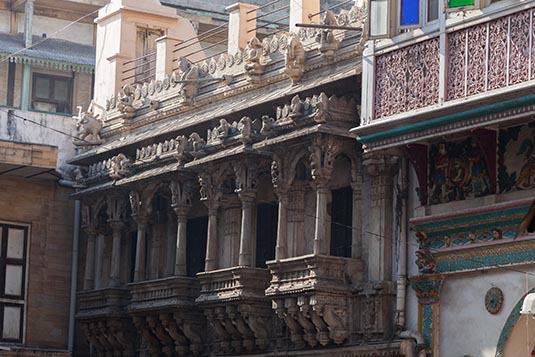 Every time it was ransacked, the city of Amdavad (locals love to call it that way), bounced back. The residents built ingenious neighborhoods that protected individual trade and their community. These residential & business quarters are called Pol. Centuries have passed and they are still functional. It’s indeed a ‘living heritage’ experience as one walks through various Pols and mingle with the residents. 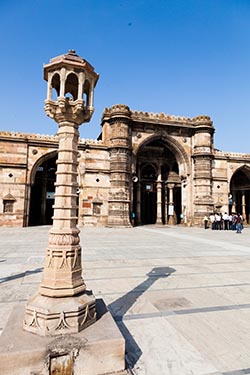 I was on a short tour of the region. The purpose was to visit Nal Sarovar and the Little Rann of Kutch. Ahmedabad was a gateway city. Since I had only a day to explore Ahmedabad, it was only natural to restrict my movements in the old quarters of this flourishing city and a couple of other monuments.
I was on a short tour of the region. The purpose was to visit Nal Sarovar and the Little Rann of Kutch. Ahmedabad was a gateway city. Since I had only a day to explore Ahmedabad, it was only natural to restrict my movements in the old quarters of this flourishing city and a couple of other monuments.
The city has been a former capital of Gujarat (the capital now is Gandhinagar, about 30 kms from downtown) and has been the home to most important leaders of India like Mahatma Gandhi and Sardar Patel during the Indian independence movement. There is a legend associated with Ahmedabad. At the beginning of the fifteenth century, an independent sultanate ruled by the Muslim Muzaffarid dynasty was established in Gujarat. Sultan Ahmed Shah, while camping on the banks of the Sabarmati River, saw a hare chasing a dog. The sultan was intrigued by this and asked his spiritual adviser for explanation. The sage pointed out unique characteristics in the land which nurtured such rare qualities which turned a timid hare to chase a ferocious dog. Impressed by this, the sultan, who had been looking for a place to build his new capital, decided to found the capital here and called it Ahmedabad. 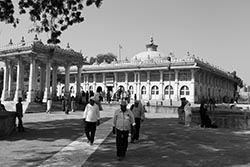 On founding the city in 1411, Ahmed Shah invited merchants and traders to the new city, which became a prosperous commercial, trading and industrial city, with textiles as its most important products. Wealthy Hindu and Jain merchants made up the commercial class dominating the community, while Muslims were the skilled weavers working for them. An efficient system of lending, banking, credit and accounting developed, and Ahmedabad financiers developed a sophisticated banking network across the country.
On founding the city in 1411, Ahmed Shah invited merchants and traders to the new city, which became a prosperous commercial, trading and industrial city, with textiles as its most important products. Wealthy Hindu and Jain merchants made up the commercial class dominating the community, while Muslims were the skilled weavers working for them. An efficient system of lending, banking, credit and accounting developed, and Ahmedabad financiers developed a sophisticated banking network across the country.
Gujarat was conquered by the Sultanate of Delhi at the end of the thirteenth century. In 1487 Mahmud Begada, the grandson of Ahmed Shah, fortified the city with an outer city wall six miles in circumference and consisting of 12 gates, 189 bastions and over 6,000 battlements to protect it from outside invaders. The last Sultan of Ahmedabad was Muzaffar II. 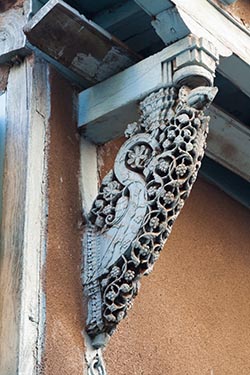 Gujarat was conquered by the Mughal emperor Akbar in 1573. During the Mughal reign, Ahmedabad became one of the empire's thriving centers of trade, especially in textiles, which were exported as far as Europe. Jehangir, son of Akbar, visited Ahmedabad in 1617 but did not like it and called it Gardabad!
Gujarat was conquered by the Mughal emperor Akbar in 1573. During the Mughal reign, Ahmedabad became one of the empire's thriving centers of trade, especially in textiles, which were exported as far as Europe. Jehangir, son of Akbar, visited Ahmedabad in 1617 but did not like it and called it Gardabad!
In 1753, the armies of the Maratha generals Raghunath Rao and Damaji Gaekwad captured the city and ended Mughal rule in Ahmedabad. A famine in 1630 and the constant power struggle between the Peshwa and the Gaekwad virtually destroyed the city. Many suburbs of the city were deserted and many mansions lay in ruins. The British East India Company took over the city in 1818. A military cantonment was established in 1824, a municipal government in 1858, and a railway link between Ahmedabad and Bombay (Mumbai) in 1864. Ahmedabad grew rapidly, becoming an important center of trade and textile manufacturing. When India got her independence from the British Raj, Ahmedabad became a provincial town of Bombay. On May 1, 1960, Ahmedabad became a state capital as a result of the bifurcation of the state of Bombay into two states of Maharashtra and Gujarat. 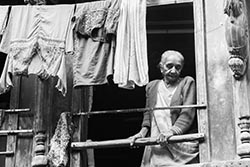 A special feature of Ahmedabad is the plan of the old city, comprising numerous Pols - self-contained neighbourhoods sheltering large number of people. Pol is a term derived from the Sanskrit word Pratoli which means a gate or an entry.
A special feature of Ahmedabad is the plan of the old city, comprising numerous Pols - self-contained neighbourhoods sheltering large number of people. Pol is a term derived from the Sanskrit word Pratoli which means a gate or an entry.
Ahmedabad Municipal Corporation organizes a heritage walk every morning and evening. I opted for the morning tour. It’s a 2-hour guided tour that commences from Swaminarayan Mandir at 8AM and ends at Jumma Masjid at 10AM. The two hours were a real enriching experience. There’s a nominal fee to take this walking tour. 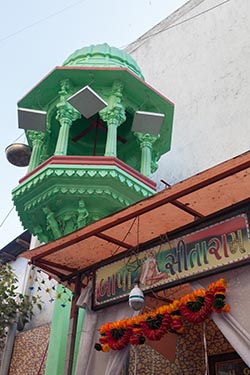 Pols are virtually small villages usually terminating in squares with community wells and chabutaras (raised platforms) for feeding birds. These Pols are protected by gates and secret passages.
Pols are virtually small villages usually terminating in squares with community wells and chabutaras (raised platforms) for feeding birds. These Pols are protected by gates and secret passages.
The names of the Pols generally gives an idea of the trade or the community that dwells within. For instance Zaveri (a jeweler) Pol would indicate that goldsmiths would be living in there. Communities were formed by the trade and to some extent by caste, whereby festivals could be celebrated in common. Distinct features of the Pol are the bird feeders, places of worships, sewer markers and intricately carved homes. Some of the monuments and places of interests that my walk took me through: Swaminarayan Temple: This was the first temple of the Swaminarayan Sampraday (sect) constructed as per scriptural norms with intricate carving in pure Burma teakwood and constructed with sculptural art by depicting deities, episodes, auspicious symbols and religious icons representing axiomatic religion and Indian culture. 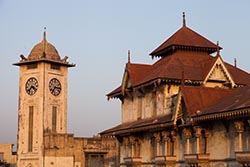 Kavi Dalpatram Chowk: Nanalal Dalpatram Kavi was a noted author and poet of Gujarati literature, and was given a title of "Kavishwar" (God of Poets) by people of Gujarat. All his writing is characterized by a distinctive diction of his own, unsurpassed in sweetness and charm, and by a consistent strain of high moral purpose coming from his poetic creed, seeing the poet as a prophet. Quite a good many lyrics of Nanalal are gems of Gujarati poetry which have enriched Gujarati literature for all time. His one of the Greatest prayers 'Asatyo Mahethi' is still being sung in the schools of Gujarat.
Kavi Dalpatram Chowk: Nanalal Dalpatram Kavi was a noted author and poet of Gujarati literature, and was given a title of "Kavishwar" (God of Poets) by people of Gujarat. All his writing is characterized by a distinctive diction of his own, unsurpassed in sweetness and charm, and by a consistent strain of high moral purpose coming from his poetic creed, seeing the poet as a prophet. Quite a good many lyrics of Nanalal are gems of Gujarati poetry which have enriched Gujarati literature for all time. His one of the Greatest prayers 'Asatyo Mahethi' is still being sung in the schools of Gujarat.
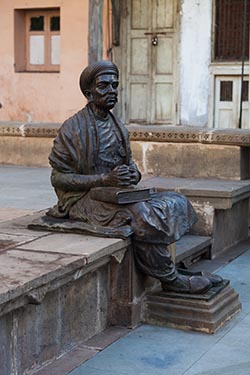 Rani No Hajiro: The street leading to the Rani No Hajiro (Queen’s tomb), where the female members of the royal family were buried, is now a market for women's clothing, jewellery and accessories. Many types of mouth freshners, spices and food stalls surround the area.
Rani No Hajiro: The street leading to the Rani No Hajiro (Queen’s tomb), where the female members of the royal family were buried, is now a market for women's clothing, jewellery and accessories. Many types of mouth freshners, spices and food stalls surround the area.
Badshah No Hajiro: This is where the male members of the royal family were buried. Ahmed Shah I, founder of Ahmedabad was buried here. Women are not allowed to enter, and men must wear something to cover their heads before entering. There are also a few ministers’ tombs laid out across the road. Old Stock Exchange Building: The stock exchange was established in 1894. It is the oldest stock exchange after Bombay Stock Exchange in India. It was functional till 1996. It’s a heritage building and an example of British architecture. Manek Chowk: This bustling open square near the center of the city functions as a vegetable market in the morning and a jewellery market in the afternoon. It is most famous, however, for its food stalls that start to emerge around 9:30 in the evening and continue till late night, with various local street snacks. 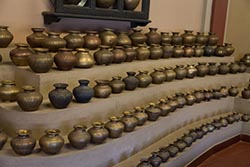 Jumma Masjid: The mosque Jama Masjid (meaning Friday Mosque) is the most splendid mosque of Ahmedabad, built in 1424 during the reign of Ahmed Shah and was probably the largest mosque in the Indian subcontinent built in this period. Designed as part of a major plan desired by the Emperor Sultan Ahmed Shah, the mosque is located south of the processional axis that runs from the Maidan-i Shah at the door with three arches - Teen Darwaza. To the west of the mosque are the tombs of Ahmed Shah, his son and his grandson (Ahmad Shah Rauza). Nearby are the graves of the queen and the other wives of the Sultan.
Jumma Masjid: The mosque Jama Masjid (meaning Friday Mosque) is the most splendid mosque of Ahmedabad, built in 1424 during the reign of Ahmed Shah and was probably the largest mosque in the Indian subcontinent built in this period. Designed as part of a major plan desired by the Emperor Sultan Ahmed Shah, the mosque is located south of the processional axis that runs from the Maidan-i Shah at the door with three arches - Teen Darwaza. To the west of the mosque are the tombs of Ahmed Shah, his son and his grandson (Ahmad Shah Rauza). Nearby are the graves of the queen and the other wives of the Sultan.
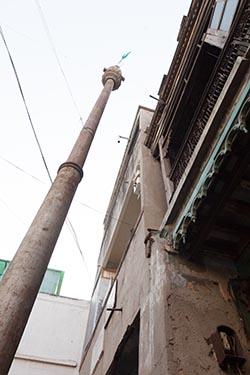 Built with yellow sandstone, the mosque complex is centered on a large rectangular courtyard 75 m long and 66 m wide. One enters the court by three entrances, one at the center of each side. The courtyard is lined with a colonnade on three sides, the prayer hall occupies the fourth (east) side. In the center of the courtyard is a rectangular basin for ablutions.
Built with yellow sandstone, the mosque complex is centered on a large rectangular courtyard 75 m long and 66 m wide. One enters the court by three entrances, one at the center of each side. The courtyard is lined with a colonnade on three sides, the prayer hall occupies the fourth (east) side. In the center of the courtyard is a rectangular basin for ablutions.
The prayer room is also rectangular and covered by four domes. In its Indo-Saracenic architecture, the mosque also contains many syncretic elements not necessarily obvious to the viewer: some of the central domes are carved like lotus flowers, closely related to the typical domes of Jain temples; and some of the pillars are carved with the form of a bell hanging on a chain, in reference to the bells that often hang in Hindu temples. The walk ended at Jumma Masjid, leaving me hungry. When in Ahmedabad it’s a good idea to try local delicacies to give you more than enough calories. Some favourite breakfast snacks include jalebis, phapdas, dhoklas and of course maska pav and ukalu ni chai. 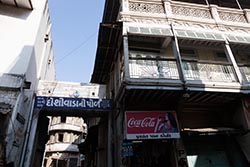 After a wholesome breakfast, I went back to my hotel and checked out. I had two more visits lined up before catching my flight back home later in the afternoon. When short of time, having a chauffeur driven car at your disposal is a definite boon.
After a wholesome breakfast, I went back to my hotel and checked out. I had two more visits lined up before catching my flight back home later in the afternoon. When short of time, having a chauffeur driven car at your disposal is a definite boon.
Built in 1573, the Sidi Saiyyed Mosque, is one of the most famous mosques of Ahmedabad. As attested by the marble stone tablet fixed on the wall of the mosque, it was built by Sidi Saiyyed, general in the army of the last Sultan Shamsuddin Muzaffar Shah III of the Gujarat Sultanate. 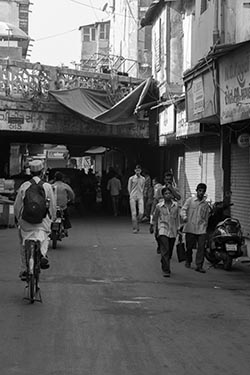 The mosque is entirely arcuated and is famous for beautifully carved ten stone latticework jalis (windows) on the side and rear arches. The rear wall is filled with square stone pierced panels in geometrical designs. The two bays flanking the central aisle have reticulated stone slabs carved in designs of intertwined trees and foliage and a palm motif. This intricately carved lattice stone window is the Sidi Saiyyed Jali, the unofficial symbol of the city and the inspiration for the design of the logo of the Indian Institute of Management of Ahmedabad.
The mosque is entirely arcuated and is famous for beautifully carved ten stone latticework jalis (windows) on the side and rear arches. The rear wall is filled with square stone pierced panels in geometrical designs. The two bays flanking the central aisle have reticulated stone slabs carved in designs of intertwined trees and foliage and a palm motif. This intricately carved lattice stone window is the Sidi Saiyyed Jali, the unofficial symbol of the city and the inspiration for the design of the logo of the Indian Institute of Management of Ahmedabad.
Sarkhej Roza is a mosque located in the village of Makraba, 7 km south-west of Ahmedabad. The mosque is known as Ahmedabad's Acropolis, due to 20th century architect Le Corbusier's famous comparison of this mosque's design to the Acropolis of Athens. Sarkhej was once a prominent centre of Sufi culture in the country, where influential Sufi saint Ganj Baksh lived. It was on the saint's suggestion that Sultan Ahmed Shah set up his capital on the banks of the Sabarmati, a few miles away from Sarkhej. 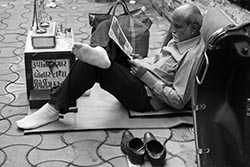 The Sarkhej Roza complex has been interpreted as being composed of both body & soul, giving it the qualities of a human being. The intricate stone carvings and stark beauty of the complex reflect the beauty of the soul of the roza's patron-saint Ganj Baksh. The credit for Roza's architecture goes to Azam and Muazzam; two Persian brothers.
The Sarkhej Roza complex has been interpreted as being composed of both body & soul, giving it the qualities of a human being. The intricate stone carvings and stark beauty of the complex reflect the beauty of the soul of the roza's patron-saint Ganj Baksh. The credit for Roza's architecture goes to Azam and Muazzam; two Persian brothers.
Like many monuments built during that period, the Sarkhej Roza fused both Muslim and Hindu principles of architecture. While the ringed domes, the profusion of pillars and brackets follow the Islamic genre, much of the ornamentation and motifs have Hindu designs. Most of the buildings don't have arches and depend on pierced stone trellises for stability. In its architecture, Sarkhej Roza is an example of the early Islamic architectural culture of the region, which fused Islamic stylistic influences from Persia with indigenous Hindu and Jain features to form a composite Indo-Saracenic architectural style. 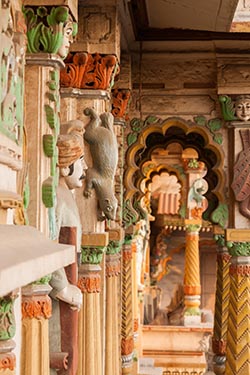 Although Sultan Qutubuddin Ahmed Shah II completed the Roza between 1451 and 1458, it was the next sultan, Mehmud Begada, who gave the complex its present grandeur. He expanded it by building the pleasure palaces, gave finishing touches to the tank and added his own tomb just across the courtyard from the saint's.
Although Sultan Qutubuddin Ahmed Shah II completed the Roza between 1451 and 1458, it was the next sultan, Mehmud Begada, who gave the complex its present grandeur. He expanded it by building the pleasure palaces, gave finishing touches to the tank and added his own tomb just across the courtyard from the saint's.
It was already 2PM. Time to visit Vishalla on the outskirts of town for a quick bite and a visit to the famous utensil museum. Vishalla is a traditionally designed restaurant. The designer, Surendra Patel, discovered the name in the book Bhattachintamani of a religious group called Swaminarayan. The place where there are no closed rooms or halls, lanterns used instead of heavy lighting, natural air replacing air-conditioners, folk songs being sung without mikes, muddy lanes, homely food served on a tree leaf, and everything around resembling a typical Indian village. Vishalla prides itself with its museum of old utensils known as Vechaar. The museum found its way into Vishalla three years after Vishalla was started. Vechaar is the only museum of its kind in the world, displaying a precious collection of utensils. These utensils have been handed down through the changing seasons and times, over the years. They speak of the unmatched art and genius of humankind of the bygone era when people did not have the modern facilities of our times. I left the place at 4PM and rushed to the airport which was about 40-minutes away… just in time to board my flight to Pune, my home town. Ahmedabad Image Gallery  Photo viewer Photo viewer
|
|
|
Home |
Charity |
Feedback
Privacy Policy | Terms of Usage © YoGoYo.com. All rights reserved. |

































































